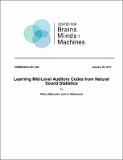| dc.contributor.author | Mlynarski, Wiktor | |
| dc.contributor.author | McDermott, Josh | |
| dc.date.accessioned | 2017-01-25T20:38:48Z | |
| dc.date.available | 2017-01-25T20:38:48Z | |
| dc.date.issued | 2017-01-25 | |
| dc.identifier.uri | http://hdl.handle.net/1721.1/106624 | |
| dc.description.abstract | Interaction with the world requires an organism to transform sensory signals into representations in which behaviorally meaningful properties of the environment are made explicit. These representations are derived through cascades of neuronal processing stages in which neurons at each stage recode the output of preceding stages. Explanations of sensory coding may thus involve understanding how low-level patterns are combined into more complex structures. Although models exist in the visual domain to explain how mid-level features such as junctions and curves might be derived from oriented filters in early visual cortex, little is known about analogous grouping principles for mid-level auditory representations. We propose a hierarchical generative model of natural sounds that learns combina- tions of spectrotemporal features from natural stimulus statistics. In the first layer the model forms a sparse convolutional code of spectrograms using a dictionary of learned spectrotemporal kernels. To generalize from specific kernel activation patterns, the second layer encodes patterns of time-varying magnitude of multiple first layer coefficients. Because second-layer features are sensitive to combi- nations of spectrotemporal features, the representation they support encodes more complex acoustic patterns than the first layer. When trained on corpora of speech and environmental sounds, some second-layer units learned to group spectrotemporal features that occur together in natural sounds. Others instantiate opponency between dissimilar sets of spectrotemporal features. Such groupings might be instantiated by neurons in the auditory cortex, providing a hypothesis for mid-level neuronal computation. | en_US |
| dc.description.sponsorship | This work was supported by the Center for Brains, Minds and Machines (CBMM), funded by NSF STC award CCF-1231216. | en_US |
| dc.language.iso | en_US | en_US |
| dc.publisher | Center for Brains, Minds and Machines (CBMM), arXiv | en_US |
| dc.relation.ispartofseries | CBMM Memo Series;060 | |
| dc.rights | Attribution-NonCommercial-ShareAlike 3.0 United States | * |
| dc.rights.uri | http://creativecommons.org/licenses/by-nc-sa/3.0/us/ | * |
| dc.subject | Auditory Representations | en_US |
| dc.subject | auditory cortex | en_US |
| dc.subject | spectrotemporal features | en_US |
| dc.title | Learning Mid-Level Auditory Codes from Natural Sound Statistics | en_US |
| dc.type | Technical Report | en_US |
| dc.type | Working Paper | en_US |
| dc.type | Other | en_US |

